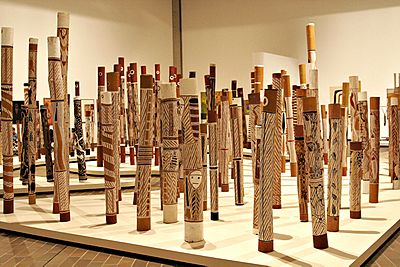Aboriginal Memorial facts for kids
Quick facts for kids The Aboriginal Memorial |
|
|---|---|
 |
|
| Artist | Artists of Ramingining, central Arnhem Land, Northern Territory, Australia |
| Year | 1987 |
| Type | Sculpture installation: natural pigments on wood |
| Location | National Gallery of Australia, Canberra |
The Aboriginal Memorial is a special artwork from the late 1980s. It is made up of 200 decorated hollow log coffins. These are also called memorial poles or dupun.
This artwork was thought up by Djon Mundine in 1987–88. Forty-three artists from Ramingining and nearby areas in Central Arnhem Land, in the Northern Territory, helped create it. Famous artists like David Malangi and George Milpurrurru were part of the project.
The Aboriginal Memorial was made to remember a big event in Australia's history. It was created to mark 200 years since European people first settled in Australia. The artwork honors the many Indigenous Australians who died because of this settlement.
Today, the artwork is owned by the National Gallery of Australia in Canberra. You can see it there all the time. It was first shown at the Sydney Biennale in 1988. It was also a main part of an Indigenous art show at Russia's Hermitage Museum in 2000.
About The Aboriginal Memorial
The Aboriginal Memorial is a powerful art piece. It helps people remember an important part of Australia's past. It shows how art can tell stories and honor people.
Why Was It Created?
In 1988, Australia celebrated 200 years since the first European settlement. This happened when Captain Arthur Phillip arrived at Sydney Harbour in 1788. For many Indigenous Australians, this day is known as Invasion Day. It marks a time of great change and loss.
A group of Indigenous artists from Ramingining decided to create an artwork for this anniversary. Djon Mundine, an Indigenous art expert, started the idea. A small group of artists, including David Malangi, Paddy Dhathangu, George Milpurrurru, and Jimmy Wululu, planned the project. In the end, 43 artists from the area helped make the Memorial.
The artwork has 200 hollow log coffins, called dupun. The number 200 was chosen to match the 200 years of European settlement. These log coffins are a type of funerary art. They are used in Arnhem Land for special reburial ceremonies.
However, the logs in the Aboriginal Memorial were made just for this artwork. They have never held human remains. They were not used in real reburial ceremonies. The goal was to remember the thousands of Aboriginal people who died during European settlement. It was a way to honor them when traditional ceremonies were not possible.
How It Was Made
The log coffins are made from trees that termites have naturally hollowed out. First, the artists cut and clean the logs. Then, they paint them with natural colors during a special ceremony.
The decorations on the Aboriginal Memorial logs show traditional designs from different clans. They also show important dreamings. These are special stories and beliefs that each artist was responsible for sharing. Each log tells a unique story from the artist's culture.
See also
 In Spanish: Monumento conmemorativo aborigen para niños
In Spanish: Monumento conmemorativo aborigen para niños

